Mechanisms Underlying the Effects of Secretory Protein G22 on Biological Characteristics and Virulence of Streptococcus suis
Abstract
1. Introduction
2. Materials and Methods
2.1. Bacterial Strains and Plasmids
2.2. Construction of G22 Gene Knockout Strain and Complementary Strain
2.3. Growth Characteristics and Genetic Stability of Mutant Strains
2.4. Observation with Transmission Electron Microscopy (TEM)
2.5. Survival Assays of SS2 in H2O2, at High Temperature, and Under Acidic Conditions
2.6. Adhesion and Invasion Assays in Caco-2 and HEp-2 Cells
2.7. Anti-Phagocytosis Analysis in RAW 264.7 Macrophages
2.8. Whole-Blood Bactericidal Assay
2.9. Experimental Infection of Mice
2.10. RNA Sequencing Analysis
2.11. Statistical Analysis
3. Results
3.1. Identification of G22 Gene Knockout Strain and Complementary Strain
3.2. Characterization of Mutant Strain ∆G22
3.3. Role of G22 in Oxidative Stress Tolerance of SS2
3.4. Role of G22 in Adhesion to and Invasion of Host Cells by SS2
3.5. Role of G22 in Resistance of SS2 to Host Cell Phagocytosis and Whole-Blood Resistance Assay
3.6. Knockout of G22 Significantly Reduces Mortality
3.7. Colonization of Mouse Tissues by WT and ∆G22 Strains
3.8. Significant Bacterial Transcriptomic Changes with G22 Gene Deletion
4. Discussion
Supplementary Materials
Author Contributions
Funding
Institutional Review Board Statement
Informed Consent Statement
Data Availability Statement
Conflicts of Interest
References
- Gottschalk, M.; Segura, M.; Xu, J. Streptococcus suis infections in humans: The Chinese experience and the situation in North America. Anim. Health Res. Rev. 2007, 8, 29–45. [Google Scholar] [PubMed]
- Goyette-Desjardins, G.; Auger, J.-P.; Xu, J.; Segura, M.; Gottschalk, M. Streptococcus suis, an important pig pathogen and emerging zoonotic agent—An update on the worldwide distribution based on serotyping and sequence typing. Emerg. Microbes Infect. 2019, 3, 1–20. [Google Scholar]
- Nahuel, F.; Mariela, S.; Daniel, G.; Marcelo, G. Virulence factors involved in the pathogenesis of the infection caused by the swine pathogen and zoonotic agent Streptococcus suis. Future Microbiol. 2012, 7, 259–279. [Google Scholar]
- Feng, Y.; Zhang, H.; Wu, Z.; Wang, S.; Cao, M.; Hu, D.; Wang, C. Streptococcus suis infection. Virulence 2014, 5, 477–497. [Google Scholar] [CrossRef]
- Sheng, Q.; Xu, Q.; Lan, Z.; Wu, Z. Comparative Genome Analysis of TwoStreptococcus suis Serotype 8 Strains Identifies Two New Virulence-Associated Genes. Animals 2024, 14, 572. [Google Scholar] [CrossRef] [PubMed]
- Wisselink, H.J.; Smith, H.E.; Stockhofe-Zurwieden, N.; Peperkamp, K.; Vecht, U. Distribution of capsular types and production of muramidase-released protein (MRP) and extracellular factor (EF) of Streptococcus suis strains isolated from diseased pigs in seven European countries. Vet. Microbiol. 2000, 74, 237–248. [Google Scholar] [CrossRef]
- Li, Q.; Fei, X.; Zhang, Y.; Guo, G.; Shi, H.; Zhang, W. The biological role of MutT in the pathogenesis of the zoonotic pathogen Streptococcus suis serotype 2. Virulence 2021, 12, 1538–1549. [Google Scholar]
- Tang, J.; Wang, C.; Feng, Y.; Yang, W.; Song, H.; Chen, Z.; Yu, H.; Pan, X.; Zhou, X.; Wang, H.; et al. Streptococcal toxic shock syndrome caused by Streptococcus suis serotype 2. PLoS Med. 2006, 3, e151. [Google Scholar]
- Yong, H.; Shiming, F.; Geng, Z.; Anusak, K.; Xiabing, C.; Xingxing, D.; Lin, T.; Jinquan, L. Genome analysis provides insight into hyper-virulence of Streptococcus suis LSM178, a human strain with a novel sequence type 1005. Sci. Rep. 2021, 11, 23919. [Google Scholar]
- Segura, M.; Fittipaldi, N.; Calzas, C.; Gottschalk, M. Critical Streptococcus suis Virulence Factors: Are They All Really Critical? Trends Microbiol. 2017, 25, 585–599. [Google Scholar]
- Tong, W.; Hexiang, J.; Fengyang, L.; Xuan, J.; Jun, W.; Shaopeng, W.; Yi, S.; Yanyan, T.; Hong, C.; Yu, S.; et al. O-acetyl-homoserine sulfhydrylase deficient Streptococcus suis serotype 2 strain SC19 becomes an avirulent strain and provides immune protection against homotype infection in mice. Vet. Microbiol. 2024, 288, 109943. [Google Scholar]
- Xia, X.; Qin, W.; Zhu, H.; Wang, X.; Jiang, J.; Hu, J. How Streptococcus suis serotype 2 attempts to avoid attack by host immune defenses. J. Microbiol. Immunol. Infect. 2019, 52, 516–525. [Google Scholar] [CrossRef]
- Willenborg, J.; Koczula, A.; Fulde, M.; Greeff, A.D.; Beineke, A.; Eisenreich, W.; Huber, C.; Seitz, M.; Valentin-Weigand, P.; Goethe, R. FlpS, the FNR-like Protein of Streptococcus suis Is an Essential, Oxygen-Sensing Activator of the Arginine Deiminase System. Pathogens 2016, 5, 51. [Google Scholar] [CrossRef]
- Kietzman, C.C.; Caparon, M.G. CcpA and LacD.1 affect temporal regulation of Streptococcus pyogenes virulence genes. Infect. Immun. 2010, 78, 241–252. [Google Scholar] [CrossRef]
- Fritz, T.; Wolfgang, H. Global control of sugar metabolism: A gram-positive solution. Antonie Van Leeuwenhoek 2002, 82, 59–71. [Google Scholar]
- Zomer, A.L.; Buist, G.; Larsen, R.; Kok, J.; Kuipers, O.P. Time-resolved determination of the CcpA regulon of Lactococcus lactis subsp. cremoris MG1363. J. Bacteriol. 2007, 189, 1366–1381. [Google Scholar] [CrossRef]
- Shelburne, S.A., III; Keith, D.; Horstmann, N.; Sumby, P.; Davenport, M.T.; Graviss, E.A.; Brennan, R.G.; Musser, J.M. A direct link between carbohydrate utilization and virulence in the major human pathogen group A Streptococcus. Proc. Natl. Acad. Sci. USA 2008, 105, 1698–1703. [Google Scholar] [CrossRef]
- Wen, Z.T.; Burne, R.A. Functional Genomics Approach to Identifying Genes Required for Biofilm Development by Streptococcus mutans. Appl. Environ. Microbiol. 2003, 69, 722. [Google Scholar] [CrossRef]
- Willenborg, J.; Fulde, M.; De Greeff, A.; Rohde, M.; Smith, H.E.; Valentin-Weigand, P.; Goethe, R. Role of glucose and CcpA in capsule expression and virulence of Streptococcus suis. Microbiology 2011, 157, 1823–1833. [Google Scholar] [CrossRef]
- Zhou, Y.; Tu, T.; Yao, X.; Luo, Y.; Yang, Z.; Ren, M.; Zhang, G.; Yu, Y.; Lu, A.; Wang, Y. Pan-genome analysis of Streptococcus suis serotype 2 highlights genes associated with virulence and antibiotic resistance. Front. Microbiol. 2024, 15, 1362316. [Google Scholar] [CrossRef]
- Xiaowu, J.; Lexin, Z.; Dongbo, Z. Deletion of lacD gene affected stress tolerance and virulence of Streptococcus suis serotype 2. J. Microbiol. 2022, 60, 948–959. [Google Scholar]
- Dong, X.; Chao, Y.; Zhou, Y.; Zhou, R.; Zhang, W.; Fischetti, V.A.; Wang, X.; Feng, Y.; Li, J. The global emergence of a novel Streptococcus suis clade associated with human infections. EMBO Mol. Med. 2021, 13, e13810. [Google Scholar] [CrossRef] [PubMed]
- Yu, H.; Jing, H.; Chen, Z.; Zheng, H.; Zhu, X.; Wang, H.; Wang, S.; Liu, L.; Zu, R.; Luo, L.; et al. Human Streptococcus suis outbreak, Sichuan, China. Emerg. Infect. Dis. 2006, 12, 914. [Google Scholar] [CrossRef] [PubMed]
- Takamatsu, D.; Osaki, M.; Sekizaki, T. Thermosensitive Suicide Vectors for Gene Replacement in Streptococcus suis. Plasmid 2001, 46, 140–148. [Google Scholar] [CrossRef]
- Takamatsu, D.; Osaki, M.; Sekizaki, T. Construction and Characterization of Streptococcus suis—Escherichia coli Shuttle Cloning Vectors. Plasmid 2001, 45, 101–113. [Google Scholar] [CrossRef]
- Tan, M.F.; Liu, W.Q.; Zhang, C.Y.; Gao, T.; Zheng, L.L.; Qiu, D.X.; Li, L.; Zhou, R. The involvement of MsmK in pathogenesis of the Streptococcus suis serotype 2. Microbiol. Open 2017, 6, e00433. [Google Scholar] [CrossRef]
- Roy, S.; Zhu, Y.; Ma, J.; Roy, A.C.; Zhang, Y.; Zhong, X.; Pan, Z.; Yao, H. Role of ClpX and ClpP in Streptococcus suis serotype 2 stress tolerance and virulence. Microbiol. Res. 2019, 223–225, 99–109. [Google Scholar] [CrossRef]
- Zhang, Y.; Li, R.; Li, Q.; Zhu, Y.; Yang, X.; Zhao, D.; Zong, B. Orphan response regulator CovR plays positive regulative functions in the survivability and pathogenicity of Streptococcus suis serotype 2 isolated from a pig. BMC Vet. Res. 2023, 19, 243. [Google Scholar] [CrossRef]
- Zhu, H.; Wang, Y.; Ni, Y.; Zhou, J.; Han, L.; Yu, Z.; Mao, A.; Wang, D.; Fan, H.; He, K. The Redox-Sensing Regulator Rex Contributes to the Virulence and Oxidative Stress Response of Streptococcus suis Serotype 2. Front. Cell. Infect. Microbiol. 2018, 8, 317. [Google Scholar] [CrossRef]
- Cumley, N.J.; Smith, L.M.; Anthony, M.; May, R.C. The CovS/CovR acid response regulator is required for intracellular survival of group B Streptococcus in macrophages. Infect. Immun. 2012, 80, 1650–1661. [Google Scholar] [CrossRef]
- Feng, L.; Zhu, J.; Chang, H.; Gao, X.; Gao, C.; Wei, X.; Yuan, F.; Bei, W. The CodY regulator is essential for virulence in Streptococcus suis serotype 2. Sci. Rep. 2016, 6, 21241. [Google Scholar] [CrossRef] [PubMed]
- Fan, J.; Zhao, L.; Hu, Q.; Li, S.; Li, H.; Zhang, Q.; Zou, G.; Zhang, L.; Li, L.; Huang, Q.; et al. Screening for Virulence-Related Genes via a Transposon Mutant Library of Streptococcus suis Serotype 2 Using a Galleria mellonella Larvae Infection Model. Microorganisms 2022, 10, 868. [Google Scholar] [CrossRef] [PubMed]
- Servane, P.; David, R.; Anaïs, B.; Masatoshi, O.; JeanPhilippe, A.; Mariela, S.; Marcelo, G. Role of Maturation of Lipoproteins in the Pathogenesis of the Infection Caused by Streptococcus suis Serotype 2. Microorganisms 2021, 9, 2386. [Google Scholar] [CrossRef]
- Liu, L.; Zhang, Q.; Xu, Z.; Huang, J.; Zhu, W.; Zhang, A.; Sun, X.; Jin, M. HP1717 Contributes to Streptococcus suis Virulence by Inducing an Excessive Inflammatory Response and Influencing the Biosynthesis of the Capsule. Microorganisms 2019, 7, 522. [Google Scholar] [CrossRef] [PubMed]
- Esgleas, M.; Dominguez-Punaro, M.D.L.C.; Li, Y.; Harel, J.E.; Dubreuil, J.D.; Gottschalk, M. Immunization with SsEno fails to protect mice against challenge with Streptococcus suis serotype 2. FEMS Microbiol. Lett. 2009, 294, 82–88. [Google Scholar]
- Gao, S.; Shen, Y.; Yuan, S.; Quan, Y.; Li, X.; Wang, Y.; Yi, L.; Wang, Y. Methyl anthranilate deteriorates biofilm structure of Streptococcus suis and antagonizes the capsular polysaccharide defence effect. Int. J. Antimicrob. Agents 2023, 62, 106996. [Google Scholar] [CrossRef]
- Zhong, X.; Zhang, Y.; Zhu, Y.; Dong, W.; Ma, J.; Pan, Z.; Yao, H. Identification of an Autorepressing Two-Component Signaling System That Modulates Virulence in Streptococcus suis Serotype 2. Infect. Immun. 2019, 87, 10–128. [Google Scholar]
- Gu, Q.; He, P.; Wang, D.; Ma, J.; Zhong, X.; Zhu, Y.; Zhang, Y.; Bai, Q.; Pan, Z.; Yao, H. An Auto-Regulating Type II Toxin-Antitoxin System Modulates Drug Resistance and Virulence in Streptococcus suis. Front. Microbiol. 2021, 12, 671706. [Google Scholar]
- Guo, G.; Zhang, Y.; Wei, D.; Wang, Z.; Li, Q.; Yu, Y.; Zhang, W. Contribution of nadR to the cell growth and virulence of Streptococcus suis serotype 2. Vet. Microbiol. 2024, 288, 109928. [Google Scholar]
- Suzuki, Y.; Nagasawa, R.; Senpuku, H. Inhibiting effects of fructanase on competence-stimulating peptide-dependent quorum sensing system in Streptococcus mutans. J. Infect. Chemother. 2017, 23, 634–641. [Google Scholar] [CrossRef]
- Disi, L.; JinMing, F.; Jingjie, W.; Long, L.; Li, X.; Feiyu, L.; Jing, Y.; Bei, L. The Fructose-Specific Phosphotransferase System of Klebsiella pneumoniae is regulated by global regulator CRP and link to virulence and growth. Infect. Immun. 2018, 86, 10–1128. [Google Scholar]
- Haber, A.; Friedman, S.; Lobel, L.; Burg-Golani, T.; Sigal, N.; Rose, J.; Livnat-Levanon, N.; Lewinson, O.; Herskovits, A.A. L-glutamine Induces Expression of Listeria monocytogenes Virulence Genes. PLoS Pathog. 2017, 13, e1006161. [Google Scholar] [CrossRef] [PubMed]
- Yu, L.; Wang, H.; Han, X.; Li, W.; Xue, M.; Qi, K.; Chen, X.; Ni, J.; Deng, R.; Shang, F.; et al. The two-component system, BasSR, is involved in the regulation of biofilm and virulence in avian pathogenic Escherichia coli. Avian Pathol. 2020, 49, 532–546. [Google Scholar] [CrossRef] [PubMed]
- Zeng, L.; Das, S.; Burne, R.A. Utilization of lactose and galactose by Streptococcus mutans: Transport, toxicity, and carbon catabolite repression. J. Bacteriol. 2010, 192, 2434–2444. [Google Scholar] [CrossRef]
- Panjaitan, N.S.; Horng, Y.T.; Chien, C.C.; Yang, H.C.; You, R.I.; Soo, P.C. The PTS Components in Klebsiella pneumoniae Affect Bacterial Capsular Polysaccharide Production and Macrophage Phagocytosis Resistance. Microorganisms 2021, 9, 335. [Google Scholar] [CrossRef] [PubMed]
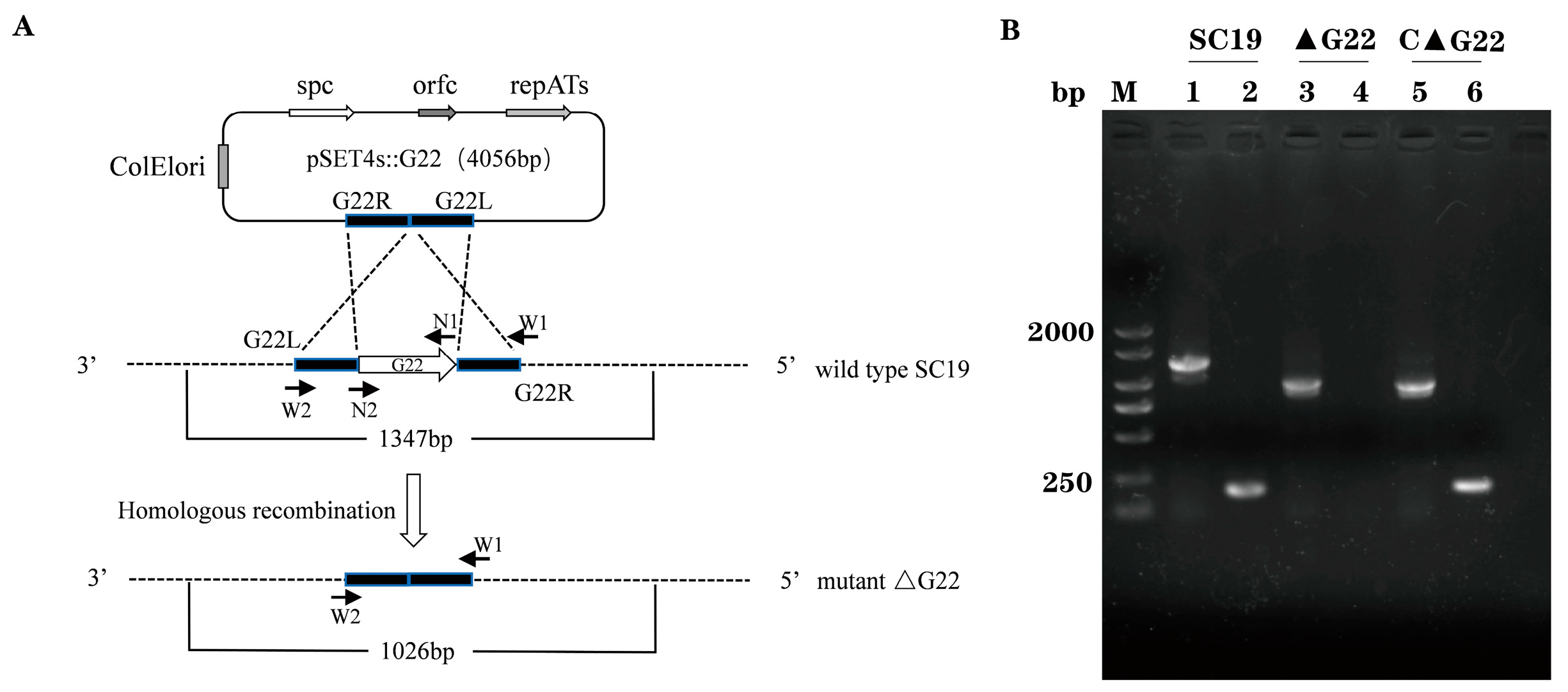

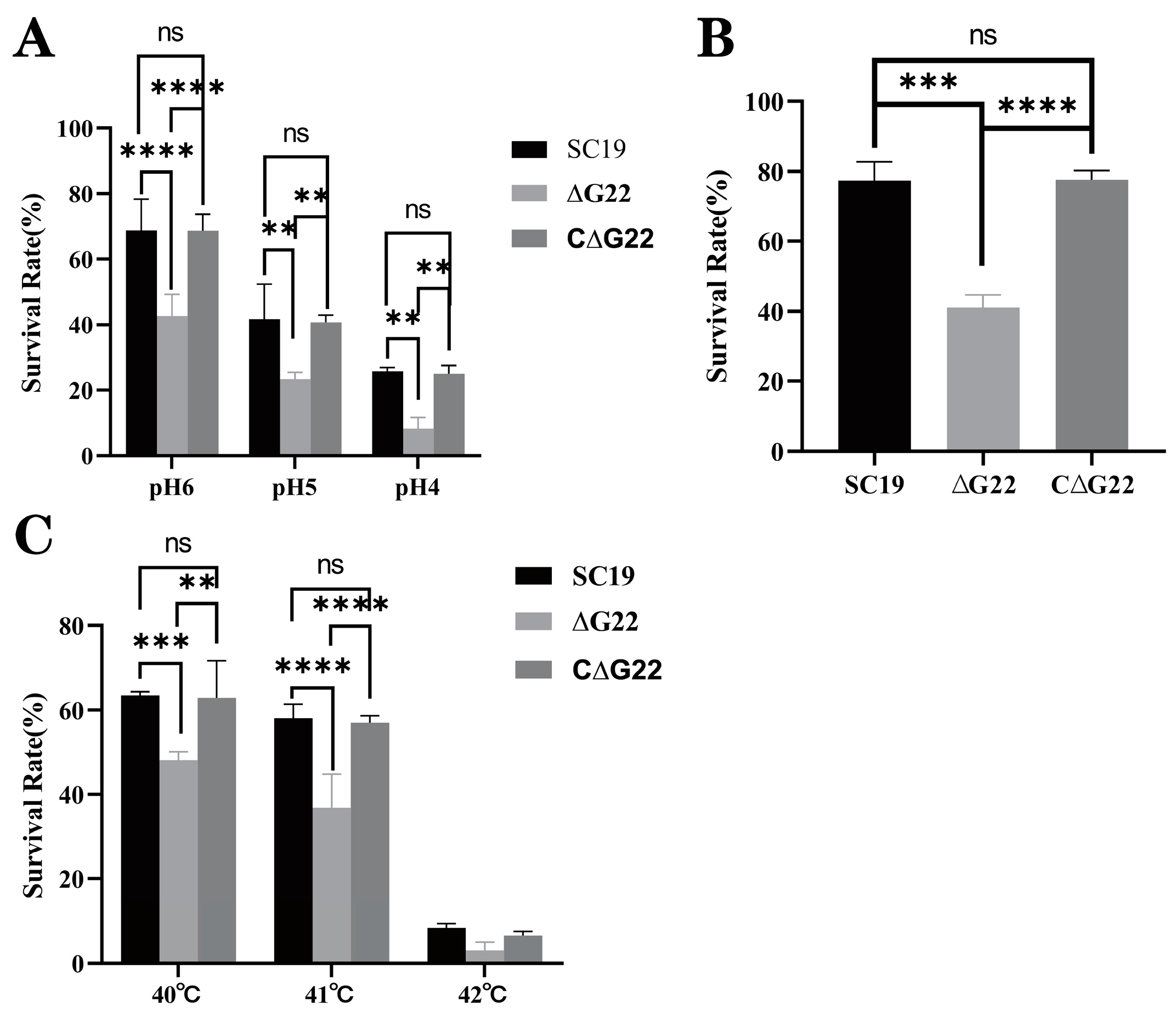

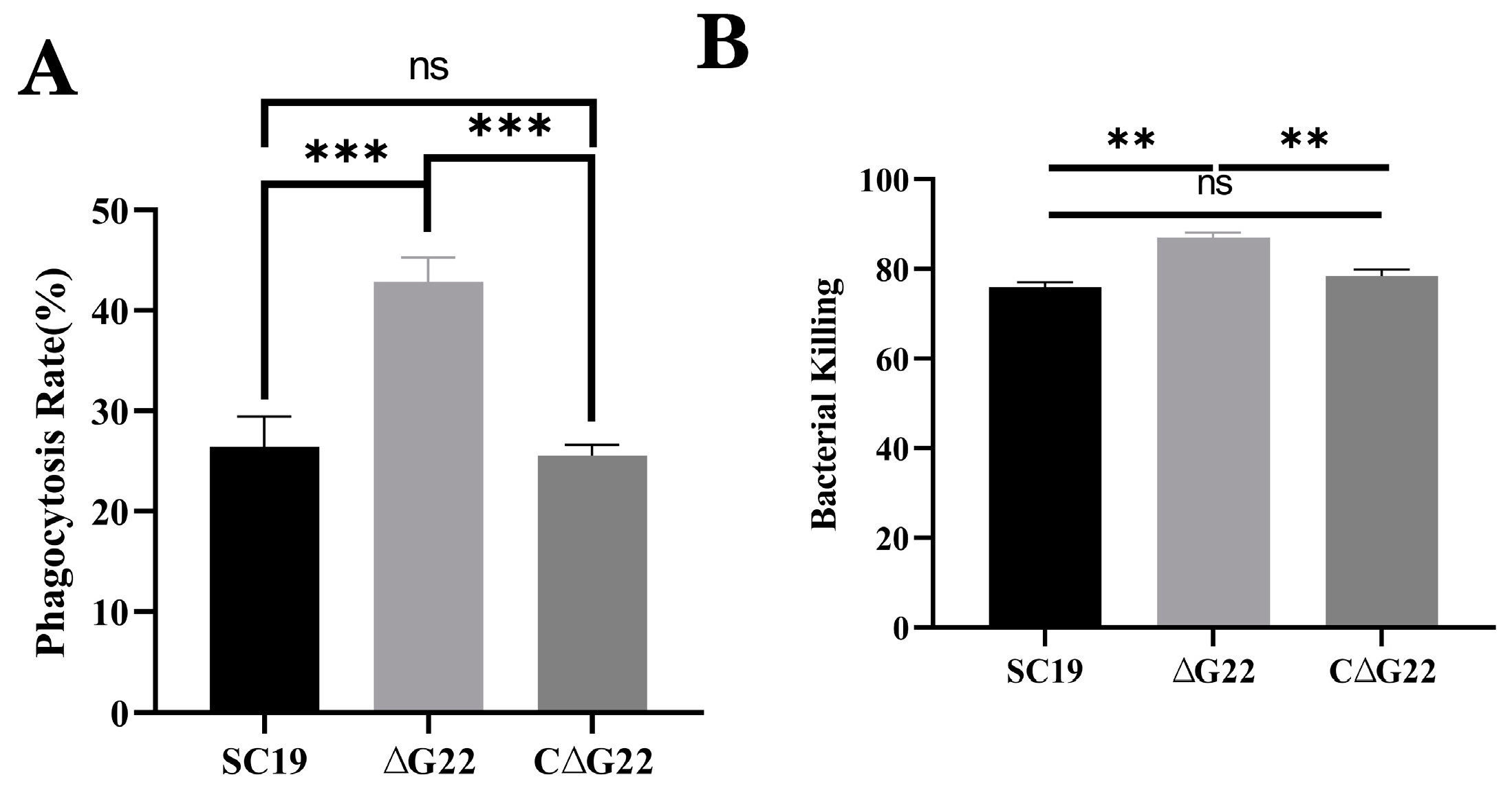
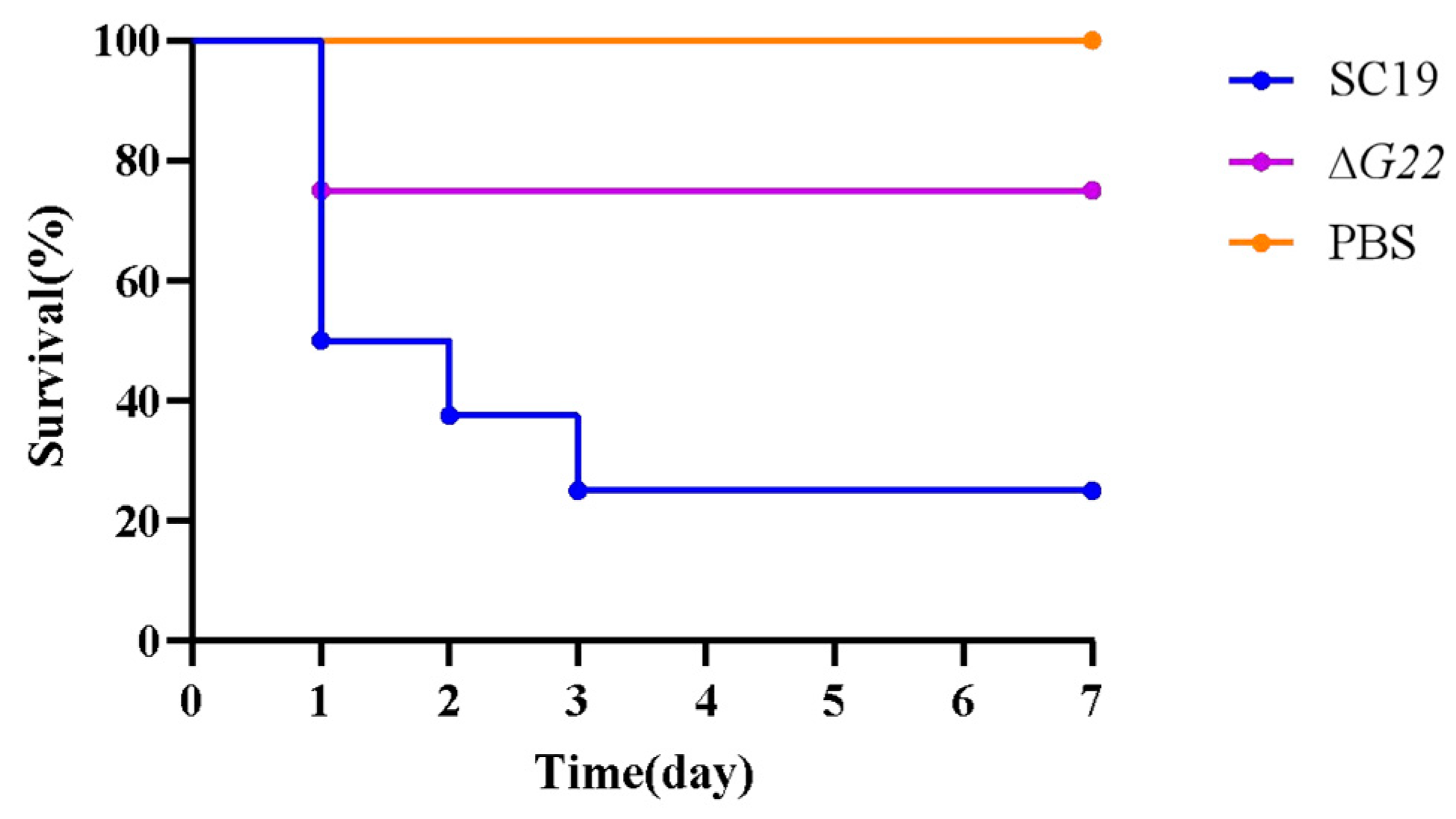

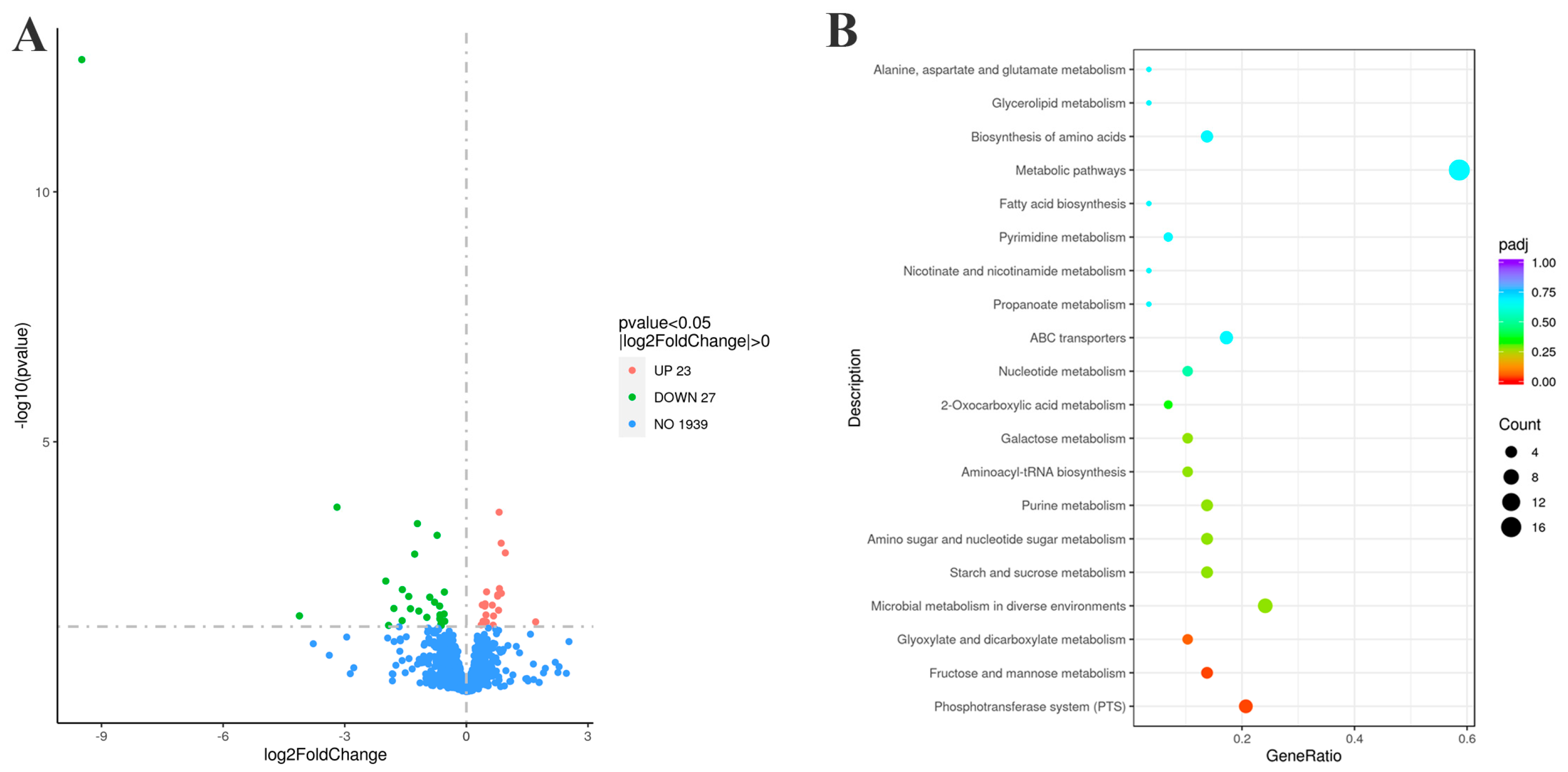
| Strain or Plasmid | Characteristics and Functions | Sources or Reference |
|---|---|---|
| SC19 | Virulent strain isolated from the brain of a dead pig; Serotype 2 | Laboratory collection |
| ∆G22 | ∆G22-deletion mutant strain | This study |
| C∆G22 | Complemented strain of G22, SpcR, CmR | This study |
| Escherichia coli DH5α | Cloning host for recombinant vector | Purchased from Shanghai Sangon Biotech Co., Ltd., Shanghai, China |
| pSET4s | Temperature-sensitive E. coli-S. suis shuttle vector, SpcR | Purchased from Shanghai Ke Lei Biological Technology Co., Ltd., Shanghai, China |
| pSET2 | E. coli-Streptococcus shuttle cloning vectors; SpcR | Laboratory collection |
| pSET4s::G22 | A recombinant vector with the background of pSET4S, designed for ΔG22, SpcR | This study |
| pSET2::G22 | pSET2 containing the G22 gene and its promoter, SpcR | This study |
| Primer | Primer Sequence (5′-3′) | Function or PCR Product |
|---|---|---|
| G22L-F | TTGTAAAACGACGGCCAGTGAATTCGAAGCAATCTGTCGTGGAGTTG | Upstream fragment amplification of G22 |
| G22L-R | ATTACTATCCACGTTTCATTTTTGAAATATCTCC | |
| G22R-F | AATGAAACGTGGATAGTAATTCAGTTTTG | Downstream fragment amplification of G22 |
| G22R-R | CTATGACCATGATTACGCCAAGCTTCCACTGTTCTCTATCCATATG | |
| W1 | TTGTAAAACGACGGCCAGTGAATTCGAAGCAATCTGTCGTGGAGTTG | Identification outside the homologous region |
| W2 | CTATGACCATGATTACGCCAAGCTTCCACTGTTCTCTATCCATATG | |
| N1 | AAGTTGGTCTGTGTGCTATGG | Internal fragment of G22 identification |
| N2 | TTAGAACCAGCAGCTCTCG |
Disclaimer/Publisher’s Note: The statements, opinions and data contained in all publications are solely those of the individual author(s) and contributor(s) and not of MDPI and/or the editor(s). MDPI and/or the editor(s) disclaim responsibility for any injury to people or property resulting from any ideas, methods, instructions or products referred to in the content. |
© 2025 by the authors. Licensee MDPI, Basel, Switzerland. This article is an open access article distributed under the terms and conditions of the Creative Commons Attribution (CC BY) license (https://creativecommons.org/licenses/by/4.0/).
Share and Cite
Fan, S.; Tan, Y.; Li, Z.; Zhang, Y.; Li, J.; Feng, Y.; He, Y.; Chen, X.; Dong, X. Mechanisms Underlying the Effects of Secretory Protein G22 on Biological Characteristics and Virulence of Streptococcus suis. Microorganisms 2025, 13, 774. https://doi.org/10.3390/microorganisms13040774
Fan S, Tan Y, Li Z, Zhang Y, Li J, Feng Y, He Y, Chen X, Dong X. Mechanisms Underlying the Effects of Secretory Protein G22 on Biological Characteristics and Virulence of Streptococcus suis. Microorganisms. 2025; 13(4):774. https://doi.org/10.3390/microorganisms13040774
Chicago/Turabian StyleFan, Shiyue, Yanping Tan, Zhiwei Li, Yanyan Zhang, Jinquan Li, Ye Feng, Yi He, Xiaoling Chen, and Xingxing Dong. 2025. "Mechanisms Underlying the Effects of Secretory Protein G22 on Biological Characteristics and Virulence of Streptococcus suis" Microorganisms 13, no. 4: 774. https://doi.org/10.3390/microorganisms13040774
APA StyleFan, S., Tan, Y., Li, Z., Zhang, Y., Li, J., Feng, Y., He, Y., Chen, X., & Dong, X. (2025). Mechanisms Underlying the Effects of Secretory Protein G22 on Biological Characteristics and Virulence of Streptococcus suis. Microorganisms, 13(4), 774. https://doi.org/10.3390/microorganisms13040774







